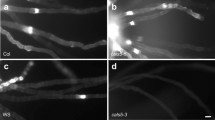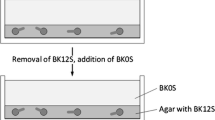Summary
In an attempt to correlate structural effects with the known dissipation of the tip-focused Ca2+ gradient caused by caffeine, we have examined the ultrastructure of caffeine-treated lily pollen tubes prepared by rapid freeze fixation and freeze substitution. We show that treatment with caffeine results in a rapid rearrangement of secretory vesicles at the pollen tube tip; the normal cone-shaped array of vesicles is rapidly dispersed. In addition, microfilament bundles appear in the tip region, where they had previously been excluded. Delocalized vesicle fusion continues in the presence of caffeine but tube extension ceases. Removal of caffeine from the growth medium initially causes tip swelling, delocalized vesicle fusion and presence of microfilaments well into the tip before normal structure and growth resume, concurrent with the previously reported return to a normal Ca2+ gradient.
Similar content being viewed by others
Abbreviations
- ER:
-
endoplasmic reticulum
- MES:
-
2-[N-morpholino] ethanesulfonic acid
- MFs:
-
microfilaments
References
Brewbaker JL, Kwack BH (1963) The essential role of calcium ion in pollen germination and pollen tube growth. Am J Bot 50: 859–865
Callewaert G, Gleeman L, Monad M (1989) Caffeine-induced Ca2+ extrusion via Na+-Ca2+ exchanger in cardiac myocytes. Am J Physiol 257: C147-C152
Derksen J, Rutten T, van Amstel T, de Win A, Doris F, Steer M (1995) Regulation of pollen tube growth. Acta Bot Neerl 44: 93–119
Endo M (1977) Calcium release from sarcoplasmic reticulum. Physiol Rev 57: 71–108
Galione A, White A (1994) Ca2+ release induced by cyclic ADP-ribose; Trends Cell Biol 4: 431–436
Geitmann A, Hudak J, Vennigerholz F, Walles B (1995) Immunogold localization of pectin and callose in pollen grains and pollen tubes ofBrugmansia suaveolens — implications for the self-incompatibility reaction. J Plant Physiol 147: 225–235
Hepler PK, Bonsignore CL (1990) Caffeine inhibition of cytokinesis: ultrastructure of cell plate formation/degradation. Protoplasma 157: 182–192
Herrero M, Dickinson HG (1981) Pollen tube development inPetunia hybrida following compatible and incompatible intraspecific matings. J Cell Sci 47: 365–383
Kandasamy MK, Kristen U (1989) Influence of triethyllead on growth and ultrastructure of tobacco pollen tubes. Environ Exp Bot 29: 283–292
Katoh K, Kikuyama M (1996) Effect of caffeine on cytosolic Ca2+ level and cytoplasmic streaming inNitella axilliformis. Protoplasma 190: 164–171
Kohno T, Shimmen T (1987) Ca2+-induced fragmentation of actin filaments in pollen tubes. Protoplasma 141: 177–179
— — (1988) Mechanism of Ca2+ inhibition of cytoplasmic streaming in lily pollen tubes. J Cell Sci 91: 501–509
Kühtreiber W, Jaffe LF (1990) Detection of extracellular calcium gradients with a calcium-specific vibrating electrode. J Cell Biol 110: 1565–1573
Lancelle SA, Hepler PK (1992) Ultrastructure of freeze-substituted pollen tubes ofLilium longiflorum. Protoplasma 167: 215–230
—, Callaham DA, Hepler PK (1986) A method for rapid freeze fixation of plant cells. Protoplasma 131: 153–165
Malhó R, Read ND, Pais MS, Trewavas AJ (1994) Role of cytosolic free calcium in the reorientation of pollen tube growth. Plant J 5: 331–341
Mascarenhas JP, Lafountain J (1972) Protoplasmic streaming, cytochalasin B, and growth of the pollen tube. Tissue Cell 4: 11–14
Miller DD, Callaham DA, Gross DJ, Hepler PK (1992) Free Ca2+ gradient in growing pollen tubes ofLilium. J Cell Sei 101: 7–12
—, Lancelle SA, Hepler PK (1996) Actin microfilaments do not form a dense meshwork inLilium longiflorum pollen tube tips. Protoplasma 195: 123–132
Obermeyer G, Weisenseel MH (1991) Calcium channel blocker and calmodulin antagonists affect the gradient of free calcium ions in lily pollen tubes. Eur J Cell Biol 56: 319–327
Picton JM, Steer MW (1983a) Evidence for the role of Ca2+ ions in tip extension in pollen tubes. Protoplasma 115: 11–17
— — (1983b) Membrane recycling and the control of secretory activity in pollen tubes. J Cell Sci 63: 303–310
— — (1985) The effects of ruthenium red, lanthanum, fluorescein isothiocyanate and trifluoperazine on vesicle transport, vesicle fusion and tip extension in pollen tubes. Planta 163: 20–26
Pierson ES, Smith PJS, Shipley AM, Jaffe LF, Cresti M, Hepler PK (1993) Ca2+ fluxes around pollen grains and pollen tubes of lily; normal development and effect of temperature shock, BAPTA- type buffer microinjection and depletion of boric acid from the medium. Biol Bull 185: 302–303
—, Miller DD, Callaham DA, Shipley AM, Rivers BA, Cresti M, Hepler PK (1994) Pollen tube growth is coupled to the extracellular calcium ion flux and the intracellular calcium gradient: effect of BAPTA-type buffers and hypertonic media. Plant Cell 6: 1815–1828
— — —, van Aken J, Hackett G, Hepler PK (1996) Tip-localized calcium entry fluctuates during pollen tube growth. Dev Biol 174: 160–173
Rathore KS, Cork RJ, Robinson KR (1991) A cytoplasmic gradient of Ca2+ is correlated with the growth of lily pollen tubes. Dev Biol 148: 612–619
Reiss H-D, Herth W (1979) Calcium lonophore A23187 affects localized wall secretion in the tip region of pollen tubes ofLilium longiflorum. Planta 145: 225–232
— — (1982) Disoriented growth of pollen tubes ofLilium longiflorum Thunb. induced by prolonged treatment with the calcium-chelating antibiotic, chlorotetracycline. Planta 156: 218–225
Samuels AL, Staehelin LA (1996) Caffeine inhibits cell plate formation by disrupting membrane reorganization just after the vesicle fusion step. Protoplasma 195: 144–155
Sawidis T, Reiss H-D (1995) Effects of heavy metals on pollen tube growth and ultrastructure. Protoplasma 185: 113–122
Subbaiah CC, Bush DS, Sachs MM (1994) Elevation of cytosolic calcium precedes anoxic gene expression in maize suspensioncultured cells. Plant Cell 6: 1747–1762
Tiwari SC, Gunning BES (1986) Development and cell surface of a non-syncytial invasive tapetum inCanna: ultrastructural, freezesubstitution, cytochemical and immunofluorescence study. Protoplasma 134: 1–16
vander Woude WJ, Morré DJ (1974) Origin and growth of cell surface components. In: Hay ED, King TJ, Papconstantinou J (eds) Macromolecules regulating growth and development. Academic Press, New York, pp 81–111
Author information
Authors and Affiliations
Rights and permissions
About this article
Cite this article
Lancelle, S.A., Cresti, M. & Hepler, P.K. Growth inhibition and recovery in freeze-substitutedLilium longiflorum pollen tubes: structural effects of caffeine. Protoplasma 196, 21–33 (1997). https://doi.org/10.1007/BF01281055
Received:
Accepted:
Issue Date:
DOI: https://doi.org/10.1007/BF01281055




